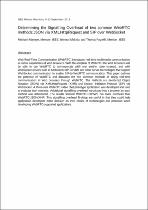 ResearchSpace
ResearchSpace
Determining the signalling overhead of two common WebRTC methods:JSON via XMLHttpRequest and SIP over WebSocket
JavaScript is disabled for your browser. Some features of this site may not work without it.
- ResearchSpace
- →
- Research Publications/Outputs
- →
- Conference Publications
- →
- View Item
| dc.contributor.author |
Adeyeye, M

|
|
| dc.contributor.author |
Makitla, I

|
|
| dc.contributor.author |
Fogwill, T

|
|
| dc.date.accessioned | 2013-12-18T10:11:10Z | |
| dc.date.available | 2013-12-18T10:11:10Z | |
| dc.date.issued | 2013-09 | |
| dc.identifier.citation | Adeyeye, M, Makitla, I and Fogwill, T. 2013. Determining the signalling overhead of two common WebRTC methods:JSON via XMLHttpRequest and SIP over WebSocket. In: IEEE Africon, Mauritius, 9-13 September 2013 | en_US |
| dc.identifier.isbn | 978-1-4673-5941-2 | |
| dc.identifier.uri | http://hdl.handle.net/10204/7129 | |
| dc.description | IEEE Africon, Mauritius, 9-13 September 2013. Abstract only attached. | en_US |
| dc.description.abstract | Web Real-Time Communication (WebRTC) introduces real-time multimedia communication as native capabilities of Web browsers. With the adoption of WebRTC the Web browsers will be able to use WebRTC to communicate with one another (peer-to-peer), and with WebSocket servers such as Mobicents SIP Servlets and other server technologies that support WebSocket communication to enable SIP-to-WebRTC communication. This paper outlines the potential of WebRTC and discusses the two common methods of doing real-time communication in Web browsers through WebRTC. The methods are JavaScript Object Notation (JSON) via XMLHttpRequest (XHR) and Session Initiation Protocol (SIP) via WebSocket. A three-user WebRTC video chat prototype application was developed and used to evaluate both methods. Additional signalling overhead introduced into a browser by each method was determined. The results showed WebRTC-SIP/WS has more overhead than WebRTC-JSON/XHR. This signalling overhead findings are useful in that they could help application developers make decision on their choice of technologies and protocols when developing WebRTC-supported applications. | en_US |
| dc.language.iso | en | en_US |
| dc.relation.ispartofseries | Workflow;11516 | |
| dc.subject | Web Real-Time Communication | en_US |
| dc.subject | WebRTC | en_US |
| dc.subject | Browser communication | en_US |
| dc.subject | JavaScript Object Notation | en_US |
| dc.subject | JSON | en_US |
| dc.subject | Session Initiation Protocol | en_US |
| dc.subject | SIP | en_US |
| dc.title | Determining the signalling overhead of two common WebRTC methods:JSON via XMLHttpRequest and SIP over WebSocket | en_US |
| dc.type | Conference Presentation | en_US |
| dc.identifier.apacitation | Adeyeye, M., Makitla, I., & Fogwill, T. (2013). Determining the signalling overhead of two common WebRTC methods:JSON via XMLHttpRequest and SIP over WebSocket. http://hdl.handle.net/10204/7129 | en_ZA |
| dc.identifier.chicagocitation | Adeyeye, M, I Makitla, and T Fogwill. "Determining the signalling overhead of two common WebRTC methods:JSON via XMLHttpRequest and SIP over WebSocket." (2013): http://hdl.handle.net/10204/7129 | en_ZA |
| dc.identifier.vancouvercitation | Adeyeye M, Makitla I, Fogwill T, Determining the signalling overhead of two common WebRTC methods:JSON via XMLHttpRequest and SIP over WebSocket; 2013. http://hdl.handle.net/10204/7129 . | en_ZA |
| dc.identifier.ris | TY - Conference Presentation AU - Adeyeye, M AU - Makitla, I AU - Fogwill, T AB - Web Real-Time Communication (WebRTC) introduces real-time multimedia communication as native capabilities of Web browsers. With the adoption of WebRTC the Web browsers will be able to use WebRTC to communicate with one another (peer-to-peer), and with WebSocket servers such as Mobicents SIP Servlets and other server technologies that support WebSocket communication to enable SIP-to-WebRTC communication. This paper outlines the potential of WebRTC and discusses the two common methods of doing real-time communication in Web browsers through WebRTC. The methods are JavaScript Object Notation (JSON) via XMLHttpRequest (XHR) and Session Initiation Protocol (SIP) via WebSocket. A three-user WebRTC video chat prototype application was developed and used to evaluate both methods. Additional signalling overhead introduced into a browser by each method was determined. The results showed WebRTC-SIP/WS has more overhead than WebRTC-JSON/XHR. This signalling overhead findings are useful in that they could help application developers make decision on their choice of technologies and protocols when developing WebRTC-supported applications. DA - 2013-09 DB - ResearchSpace DP - CSIR KW - Web Real-Time Communication KW - WebRTC KW - Browser communication KW - JavaScript Object Notation KW - JSON KW - Session Initiation Protocol KW - SIP LK - https://researchspace.csir.co.za PY - 2013 SM - 978-1-4673-5941-2 T1 - Determining the signalling overhead of two common WebRTC methods:JSON via XMLHttpRequest and SIP over WebSocket TI - Determining the signalling overhead of two common WebRTC methods:JSON via XMLHttpRequest and SIP over WebSocket UR - http://hdl.handle.net/10204/7129 ER - | en_ZA |





